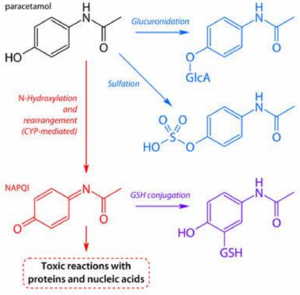6. Liver functions
Summary
- This topic focuses on the livers detoxification properties, as its metabolic functions should be known already
- The liver stores minerals like iron and copper, and vitamins like A, D, E, K and B12. Some of these vitamins are stored in amounts enough to supply the body for years!
- The liver biotransforms (processes) both exogens like drugs and food additives, and endogens, like steroid hormones and metabolites
- Biotransformation takes place in two phases. The first phase processes the molecule to give it an extra oxygen
- The second phase conjugates the molecule by adding a sugar, sulfate, glutathione or methyl to the oxygen added by the first phase. This increases solubility.
- The most important enzyme system in the first phase is the cytochrome P450 monooxygenase system.
Biotransformation
Both exogenous (originates from outside the body) and endogenous (from inside the body) molecules must be processed in the body. The liver performs most of this processing, by either modifying the molecule so it can be sent into a metabolic pathway and broken down, or by increasing its solubility so it can be excreted. This process is called biotransformation.
Molecules that are toxic are often poorly soluble, which makes it difficult for the body to both process and excrete it. These toxins are often biologically active, and by processing them they can be either made inactive or be activated. There are three ways biotransformation can affect the activity of a drug:
- The biotransformation can convert an inactive prodrug into an active compound
- This is what happens when you take aspirin. Aspirin itself is not active in the body, but is converted into salicylic acid in the liver, which is active
- The biotransformation can convert the active drug into an inactive one
- This is what happens to every drug eventually. All drugs are eventually converted into an inactive compound and excreted by the body
- The biotransformation can convert the active drug into another compound that is also active
- This happens with codeine, which is active, and is converted into morphine by the liver, which is also active
The enzymes involved in biotransformation can be divided into two categories.
| Microsomal enzymes | Non-microsomal enzymes |
|---|---|
| Inducible | Non-inducible |
| Mostly does phase I reactions | Mostly does phase II reactions |
| Membrane-bound to ER | Mostly found in mitochondria and cytoplasm |
| Mostly perform oxidation and reduction | Mostly perform hydroxylation |
| Only conjugates by glucuronidation | Conjugates in all ways except glucuronidation |
I. phase of biotransformation
The first phase of biotransformation tries to oxidize, reduce or hydrolyze the molecule to be processed. Either of these chemical reactions will give the molecule an electric charge, which will make it more soluble. The main unit of the first phase is the Cytochrome P450 monooxygenase enzyme system, a system that uses Fe3+, NADPH and O2 to add 1 oxygen atom to the molecule. 57 human genes are involved in the CYP system, which are very variable from person to person. By adding an oxygen atom to the molecule (oxidizing it) we can bind other chemical groups to the oxygen atom that help in breaking it down or excreting it. This takes us to the second phase.
II. phase of biotransformation
The second phase of biotransformation tries to attach certain chemical groups to the molecule to be processed. This is called conjugation, which just means “to attach something to a molecule”. The most important chemical groups that can be attached are glucose by glucuronidation, sulfate by sulfation, glutathione by glutathione conjugation, or methyl by methylation. After phase I., the molecule to be processed will have a polar group, often oxygen. It’s to this polar group a molecule is attached in phase II.

Glucuronidation is the most important (and most difficult to spell). It’s performed by UDP-glucuronosyl transferases, or UGTs for short. It transfers a glucuronosyl group from a UDP-glucuronic acid molecule onto the molecule to be processed. A glucuronosyl group is an oxidized derivate of glucose. UGTs are needed in bilirubin metabolism (among other things), and problems with some of these UGT enzymes cause Gilbert syndrome and Crigler-Najjar syndrome.
Sulfation involves the transfer of a sulfate group from a sulfate donor onto a molecule. The sulfate donor can be PAPS (phosphoadenosinephosphosulfate), or simply cysteine and methionine.
Glutathione can be attached to a molecule by glutathione-S-transferases, or GSTs for short.
Lastly, methylation can be performed by enzymes that use adoMet as a methyl group donor.
